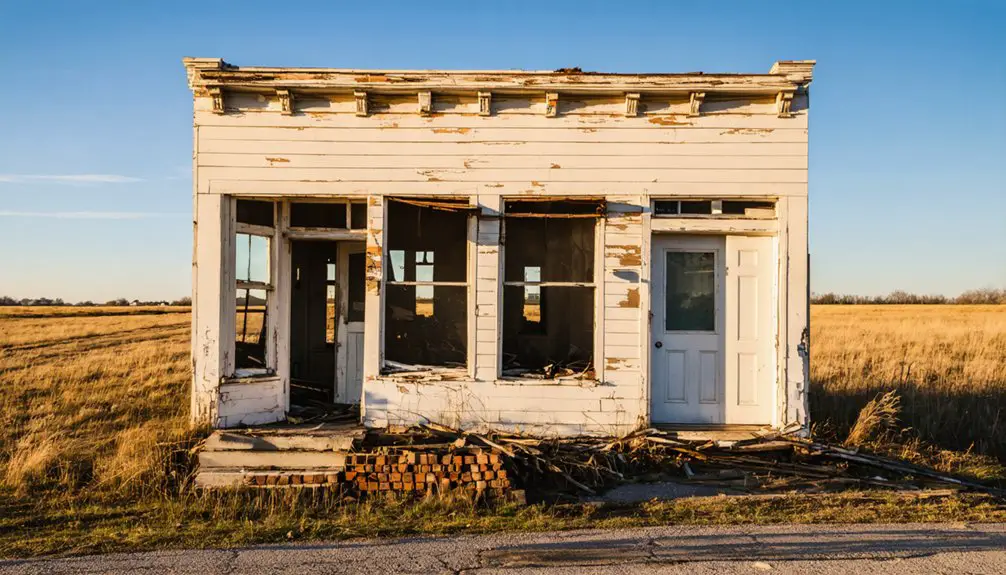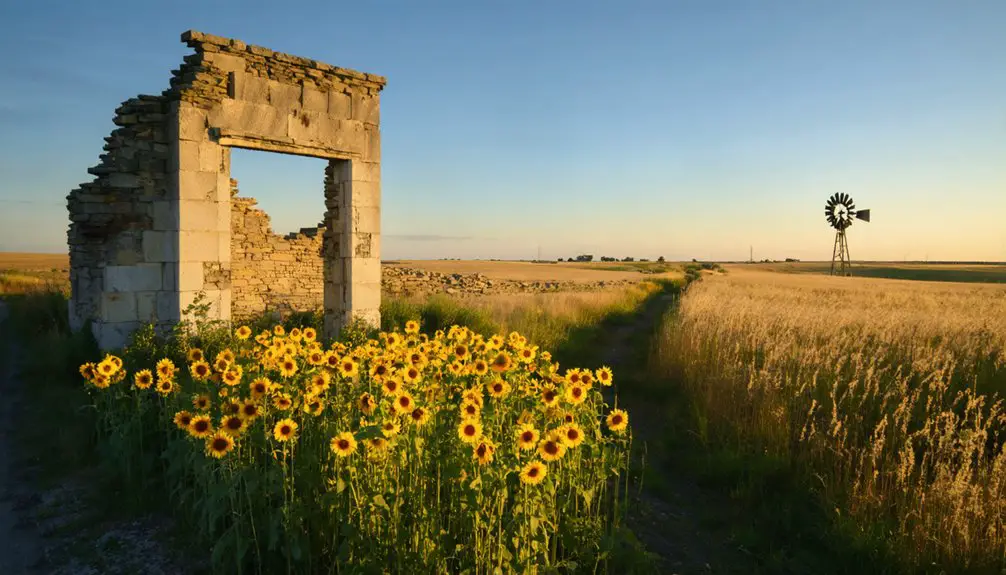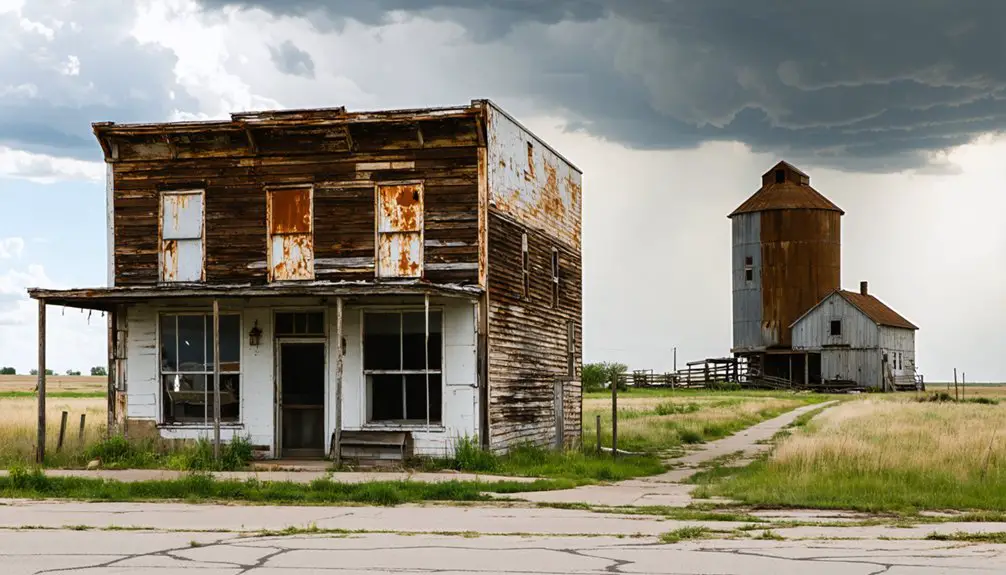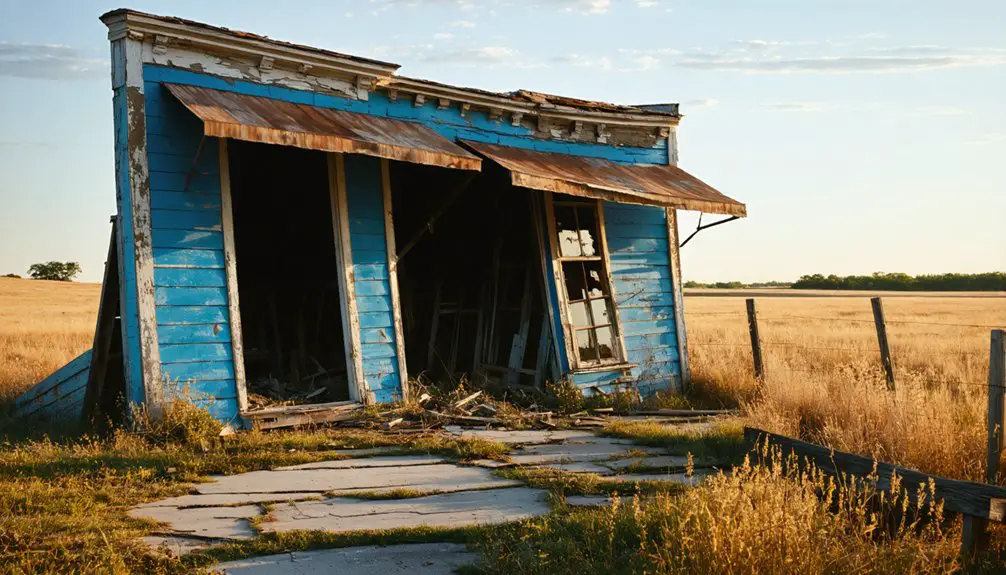You’ll find Rosalia in Butler County, Kansas, where it began as a prairie railroad town in the 1870s along the Atchison, Topeka and Santa Fe Railroad. The town reached its peak during the 1915 oil boom with 600 residents, thriving businesses, and eight nearby refineries. Today, this Flint Hills ghost town maintains just 149 residents, with abandoned tracks and weathered buildings marking its railroad heritage. The story behind its rise and fall reveals America’s fascinating frontier transformation.
Key Takeaways
- Rosalia is a Kansas ghost town with approximately 149 residents (2020 census), drastically reduced from its peak of 600 during the 1915 oil boom.
- Originally established as a prairie railroad town in the 1870s, Rosalia flourished due to the Atchison, Topeka and Santa Fe Railroad expansion.
- The town’s decline followed changes in transportation networks and industrial shifts, leaving abandoned rail corridors and building foundations.
- Located in Kansas’s Flint Hills region, Rosalia maintains its post office since 1870 despite its ghost town status.
- The site features historical remnants including weathered depots, cattle pens, and railroad bridges that showcase its railroad and oil boom heritage.
The Birth of a Prairie Railroad Town
Three major factors converged to establish Rosalia as a prairie railroad town in Kansas during the 1870s. The Atchison, Topeka and Santa Fe Railroad’s expansion through Butler County shaped railroad routes as they pushed southward through the Walnut Valley. The rapid expansion helped drive Kansas’s population to nearly one million by 1880.
You’ll find that strategic decisions about track placement weren’t random – they followed important resources and existing settlements like El Dorado while responding to local county incentives and land grants. The Missouri Pacific Railroad became a vital transportation link serving the Rosalia area.
The development of towns like Rosalia depended heavily on securing a rail connection. Communities that wanted to thrive had to negotiate with railroad companies, sometimes offering bonds or land deals to guarantee tracks would run through their territory.
These rail lines transformed simple prairie stops into crucial trade hubs, complete with grain elevators, warehouses, and the promise of economic growth.
Early Settlement and Naming Origins
While Butler County witnessed scattered settlements in the late 1860s, Rosalia’s story began with B.F. Gordy’s 160-acre land entry in March 1868. Settlement patterns soon expanded as Philip Carns took land in what would become Rosalia Township by July 1869, joining nearby settlers like A.G. Davis and William Vann in Towanda Township. The early pioneers utilized the limestone quarries to construct their buildings and homesteads. Similar to early Kansas settlements, local families needed loophole defenses in their homes for protection during uncertain times.
The area’s mix of prairie land and waterways, including De Haas Creek and Middle Branch Little Walnut River, made it attractive for agriculture and homesteading, though settlers faced challenges from lawless elements in the early 1870s.
You’ll find that Rosalia Township was officially established in 1871, preceding the town’s platting by over a decade. Following common Kansas naming traditions of the era, the first postmaster chose “Rosalia” to honor his wife when the town was platted in 1883.
Peak Years During the Oil Boom
In 1915, you’d have witnessed Rosalia’s transformation as oil workers poured into the small town after the discovery of the El Dorado field, causing the population to surge to approximately 600 residents.
You’d find temporary housing developments springing up rapidly to accommodate the influx of workers who operated the oil derricks around the clock in multiple shifts. The discovery led to Butler County’s population doubling by 1920 as oil production expanded across the region. The Barrington Oil Company became a significant player in the area after completing successful wells on the Burkett farm in 1922.
The town’s expansion included new businesses and services catering to the oil industry workforce, from drugstores that stayed open through the night to company offices managing the nearby oil leases.
Oil Workers Flood Town
During the peak of Kansas’s oil boom, Rosalia transformed from a modest farming community into a bustling town of 600 residents as oil workers flooded the region.
You’d have witnessed a dramatic economic transformation as oil companies established regional offices and created numerous job opportunities. The influx of workers required significant oil worker housing developments, leading to the creation of company towns like Oil Hill and Gordon across Butler County.
- 24/7 operations kept the oil derricks running with continuous shift work
- Eight refineries operated in nearby El Dorado and Augusta by 1918
- Oil Hill alone housed 8,000 residents with amenities like swimming pools and tennis courts
- Support businesses thrived, including drugstores that stayed open around the clock for night shift workers
Temporary Housing Developments
As oil workers poured into Rosalia, temporary housing developments rapidly transformed the landscape to accommodate the surging population.
You’d find various temporary housing trends emerging, from basic man camps to more sophisticated skid homes with multiple bedrooms. The oil industry accommodations evolved to include individual kitchens and washers/dryers, offering workers much-needed privacy and comfort. Many workers faced such severe housing shortages that they resorted to living in cars.
A notable development was the construction of a three-story hotel costing over $100,000, alongside other large buildings to house the transient workforce. Some accommodations were renting for up to $2,000 monthly despite being basic structures like double-wide trailers.
Local residents capitalized on the boom by renting properties at premium rates, while manufacturers offered multi-home discounts to support rapid deployment.
Despite these efforts, many workers still faced housing shortages, leading to innovative solutions like mobile workforce housing and communal living quarters.
Life Along the Missouri Pacific Line
If you’d visited Rosalia during its railroad heyday, you’d have found a bustling Missouri Pacific Line station where local farmers and merchants conducted their daily business amid the rhythmic sounds of steam locomotives.
During the late 1800s, under the leadership of Jay Gould’s control, the railroad expanded its reach and influence throughout the region, directly impacting communities like Rosalia.
The railroad’s infrastructure, including water towers, maintenance facilities, and telegraph offices, transformed this Kansas settlement into a crucial transportation hub connecting rural communities to larger markets.
By 1883, the Missouri Pacific had grown into an impressive network of 9,547 miles of track, demonstrating its dominance in the region’s transportation landscape.
Today’s ghost town bears little resemblance to that thriving past, with only abandoned track beds and scattered ruins hinting at the Missouri Pacific’s once-prominent role in Rosalia’s economic life.
Railroad Operations Then
The Missouri Pacific Railroad transformed daily life along its routes, particularly in small towns like Rosalia that depended on rail traffic for economic survival.
You’d find locally manufactured locomotives from St. Louis’s Palm & Robertson plant powering trains through these communities, while railroad technology continued advancing to meet growing transportation demands.
- Train and steamboat combinations cut travel time between St. Louis and Kansas City to just 50 hours in the 1850s
- Regional connectivity expanded through interchanges with the Kansas City, Leavenworth & Atchison Railway
- Heavy repair shops in Sedalia employed local workers from 1872, later consolidating operations by 1905
- The railroad’s 5-foot-6-inch gauge tracks were converted to standard gauge in 1869, enabling better connections with other lines
These operational advances helped towns like Rosalia thrive as crucial links in the expanding rail network.
Ghost Town Tracks Today
Today, ghostly remnants mark where Missouri Pacific Railroad tracks once brought life to countless small Kansas and Missouri communities.
You’ll find the ghost town relics scattered along abandoned rail corridors – old foundations, weathered depots, and forgotten cattle pens telling stories of bustling railroad history.
Where steam engines once filled their tanks at Bushong’s pond and cattle cars loaded precious cargo, you’ll now discover only quiet traces of that prosperous past.
The Osage Division’s closure in 1958 sealed the fate of many rail-dependent towns, leaving behind empty streets and crumbling infrastructure.
Former mining communities like Midway and Lichfield have nearly vanished beneath encroaching vegetation.
Yet some physical evidence endures – surviving railroad bridges, stone quarries, and town signs stand as silent witnesses to an era when the railroad meant everything to these communities.
Remnants of a Bygone Era

While many Kansas ghost towns have completely vanished, Rosalia’s physical remnants offer glimpses into its nineteenth-century origins.
You’ll find enduring traces of architectural heritage through surviving 19th and early 20th-century buildings, showcasing the community’s resilience despite decades of decline.
- The Missouri Pacific Railroad line that once fueled the town’s growth remains visible today
- A functioning school building serves as a symbol of preserved communal structures
- The historic cemetery contains the graves of early settlers, providing a tangible link to local heritage
- Some original buildings from the town’s founding era in 1883 still stand
Unlike boom-and-bust mining towns elsewhere in Kansas, Rosalia’s modest but stable past has allowed certain structures to weather time, creating a unique window into rural Kansas history.
Modern Day Population and Status
Despite its classification as a ghost town, Rosalia maintains a small but persistent population of approximately 149 residents as of the 2020 census.
Population trends show notable fluctuations, with some sources reporting a 79% increase between 2018 and 2023, while others indicate an annual decline of -1.34%. The community’s resilience is evident in its continuous operation of the post office since 1870, though local services remain limited.
You’ll find a mainly White population with a median age of 29.5 years, suggesting a relatively young demographic.
While economic data varies considerably, with conflicting poverty rates and household income figures, the town’s proximity to El Dorado (12 miles west) provides residents access to additional resources and opportunities, helping sustain this small but enduring community.
Geographic Significance in Butler County

Nestled within the distinctive Flint Hills region of Kansas, Rosalia occupies a strategic position in Butler County’s central-eastern section at coordinates 37.81583°N, 96.62056°W.
Tucked into Kansas’s rugged Flint Hills landscape, Rosalia stands sentinel in Butler County’s eastern reaches, a geographical crossroads of the region.
You’ll find this former railroad town about 12 miles east of El Dorado, situated at an elevation of 1,499 feet. While geographic isolation has limited urban development, the town’s location has shaped its historical significance.
- Located along the historic Missouri Pacific Railroad route, enhancing early transportation networks
- Positioned in the unique Flint Hills terrain, supporting cattle ranching over traditional farming
- Situated at the crossroads of county routes, maintaining essential regional connectivity
- Established in an area that later proved valuable during El Dorado’s oil boom era
Cultural Legacy in the Flint Hills
Although Rosalia’s population has dwindled over the decades, its cultural influence throughout the Flint Hills region remains remarkably vibrant.
You’ll find the town’s dedication to cultural preservation most evident in its role as a venue for community gatherings that celebrate Kansas rural traditions and pioneer heritage.
The surrounding landscape serves as a powerful source of artistic inspiration, particularly during the Symphony In The Flint Hills, which draws over 7,000 visitors.
This signature event seamlessly blends classical music with the natural prairie environment. You’ll discover how local artists and musicians continue to draw from the region’s aesthetic beauty, while historical societies document and preserve the area’s rich heritage.
Through these efforts, Rosalia maintains its position as an essential cultural touchstone in the Flint Hills, supporting heritage tourism and educational initiatives.
Factors Behind the Town’s Decline

While Rosalia’s cultural heritage endures, the town’s physical decline tells a complex story of interconnected challenges.
You’ll find the economic decline of Rosalia followed a pattern common to many Kansas ghost towns, driven by transportation changes and industrial shifts. The loss of crucial railroad connections severely impacted the town’s commerce, while agricultural mechanization meant fewer farming families could sustain the local economy.
Like countless Kansas ghost towns, Rosalia withered as railroads vanished and farms modernized, leaving an economy that could no longer sustain itself.
- The rerouting and abandonment of major rail lines cut off essential market access
- Population shifts saw younger generations moving to larger urban centers
- Aging residents and reduced birth rates created unsustainable demographics
- Closure of necessary businesses and services triggered a cycle of decline
These forces combined with the magnetic pull of nearby cities, drawing away commerce and residents until Rosalia’s vitality gradually faded.
Frequently Asked Questions
What Happened to Rosalia’s Original School Building?
You’ll find that Rosalia’s school history continues through preservation efforts, as the original building was repurposed as a 4-H facility before the Rose Hill Historical Society purchased it in 2012 for museum restoration.
Are There Any Remaining Businesses Still Operating in Rosalia Today?
While local legends hint at a richer business history, you’ll only find one operating business today: the post office, which has continuously served the community since 1870, defying rural decline.
What Was the Highest Recorded Population in Rosalia’s History?
You won’t find a definitive peak population record for Rosalia in historical documents. Based on population trends and historical significance of similar Kansas towns, it’s estimated to have never exceeded 350 residents.
Can Visitors Access and Explore the Abandoned Buildings in Rosalia?
Like a haunting echo of the past, you can’t freely enter Rosalia’s buildings. There aren’t organized ghost tours, and the deteriorating structures pose serious safety risks without proper landowner permission.
Do Any Descendants of the Original Founding Families Still Live There?
You won’t find documented descendant stories that confirm founding family legacies continuing in Rosalia today. While the town maintains 149 residents, there’s no verified record of original settlers’ descendants remaining.
References
- https://www.youtube.com/watch?v=T57uOGZ6C04
- https://legendsofkansas.com/kansas-ghost-town-list/
- https://en.wikipedia.org/wiki/Rosalia
- https://legendsofkansas.com/butler-county-kansas/
- https://en.wikipedia.org/wiki/List_of_ghost_towns_in_Kansas
- http://kansasheritage.org/research/rr/rrhistory.html
- http://genealogytrails.com/kan/butler/eightyyears141145.html
- http://www.ksgenweb.org/archives/labette/1901/202-211.html
- https://legendsofkansas.com/kansas-railroad-timeline/
- https://mostateparks.com/sites/mostateparks/files/Railroad-Related Historic Commercial and Industrial Resources in KC



